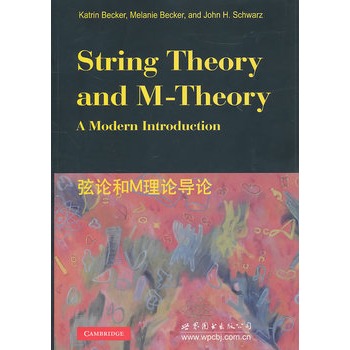《弦論和M理論導論》2011年1月1日是世界圖書出版公司出版的圖書,作者是(美國)貝克爾(Katrin Becher)。
基本介紹
- 書名:弦論和M理論導論
- 作者:(美國)貝克爾(Katrin Becher)
- 原版名稱:String Theory and M-Theory
- ISBN:7510029740, 9787510029745
- 頁數:739
- 出版社:世界圖書出版公司
- 出版時間:2011年1月1日
- 裝幀:平裝
- 版次:1
- 正文語種:英語
內容簡介,目錄,
內容簡介
《弦論和M理論導論(英文版)》內容簡介:String theory is one of the most exciting and challenging areas of moderntheoretical physics. It was developed in the late 1960s for the purpose of de- scribing the strong nuclear force. Problems were encountered that prevented this program from attaining complete success. In particular, it was realized that the spectrum of a fundamental string contains an undesired massless spimtwo particle. Quantum chromodynamics eventually proved to be the correct theory for describing the strong force and the properties of hadrons. New doors opened for string theory when in 1974 it was proposed to identify the massless spin-two particle in the string's spectrum with the graviton, the quantum of gravitation. String theory became then the most promising can didate for a quantum theory of gravity unified with the other forces and has developed into one of the most fascinating theories of high-energy physics.
目錄
Preface
1 Introduction
1.1 Historical origins
1.2 General features
1.3 Basic string theory
1.4 Modern developments in superstring theory
2 The bosonic string
2.1 p-brane actions
2.2 The string action
2.3 String sigma-model action: the classical theory
2.4 Canonical quantization
2.5 Light-cone gauge quantization
3 Conformal field theory and string interactions
3.1 Conformal field theory
3.2 BRST quantization
3.3 Background fields
3.4 Vertex operators
3.5 The structure of string perturbation theory
3.6 The linear-dilaton vacuum and noncritical strings
3.7 Witten's open-string field theory
4 Strings with world-sheet supersymmetry
4.1 Ramond-Neveu-Schwarz strings
4.2 Global world-sheet supersymmetry
4.3 Constraint equations and conformal invariance
4.4 Boundary conditions and mode expansions
4.5 Canonical quantization of the RNS string
4.6 Light-cone gauge quantization of the RNS string
4.7 SCFT and BRST
5 Strings with space-time Supersymmetry
5.1 The D0-brane action
5.2 The supersymmetric string action
5.3 Quantization of the GS action
5.4 Gauge anomalies and their cancellation
6 T-duality and D-branes
6.1 The bosonic string and Dp-branes
6.2 D-branes in type II superstring theories
6.3 Type I superstring theory
6.4 T-duality in the presence of background fields
6.5 World-volume actions for D-branes
7 The heterotic string
7.1 Nonabelian gauge symmetry in string theory
7.2 Fermionic construction of the heterotic string
7.3 Toroidal compactification
7.4 Bosonic construction of the heterotic string
8 M-theory and string duality
8.1 Low-energy effective actions
8.2 S-duality
8.3 M-theory
8.4 M-theory dualities
9 String geometry
9.1 Orbifolds
9.2 Calabi-Yau manifolds: mathematical properties
9.3 Examples of Calabi-Yau manifolds
9.4 Calabi-Yau compactifications of the heterotic string
9.5 Deformations of Calabi-Yau manifolds
9.6 Special geometry
9.7 Type IIA and type IIB on Calabi-Yau three-folds
9.8 Nonperturbative effects in Calabi-Yau compactifications
9.9 Mirror symmetry
9.10 Heterotic string theory on Calabi-Yau three-folds
9.11 K3 compactifications and more string dualities
9.12 Manifolds with G2 and Spin(7) holonomy
10 Flux compactifications
10.1 Flux compactifications and Calabi-Yau four-folds
10.2 Flux compactifications of the type IIB theory
10.3 Moduli stabilization
10.4 Fluxes, torsion and heterotic strings
10.5 The strongly coupled heterotic string
10.6 The landscape
10.7 Fluxes and cosmology
11 Black holes in string theory
11.1 Black holes in general relativity
11.2 Black-hole thermodynamics
11.3 Black holes in string theory
11.4 Statistical derivation of the entropy
11.5 The attractor mechanism
11.6 Small BPS black holes in four dimensions
12 Gauge theory/string theory dualities
12.1 Black-brane solutions in string theory and M-theory
12.2 Matrix theory
12.3 The AdS/CFT correspondence
12.4 Gauge/string duality for the conifold and generalizations
12.5 Plane-wave space-times and their duals
12.6 Geometric transitions
Bibliographic discussion
Bibliography
Index

